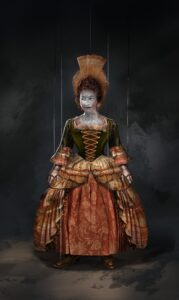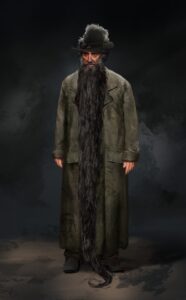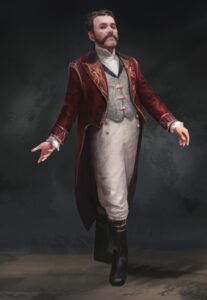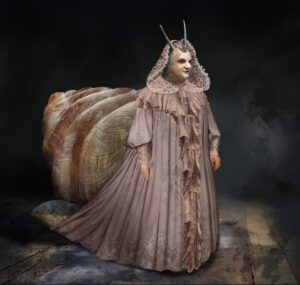
This year’s Best Costume Design race at the Academy Awards presents voters a difficult choice between five deserving but different styles of designing actors’ wardrobes. We spoke to Mank’s Trish Sommerville earlier this season, and she squares off against BAFTA, Costume Designers Guild, and Critics Choice winner (and past Oscar winner) Ann Roth (who won for The English Patient). The two also must contend with the period pieces of Emma, and the flashy costumes of Disney’s Mulan.
This week, however, Below the Line spoke to Massimo Cantini Parrini, who was responsible for the nuanced, varied, and exquisitely detailed costumes in Matteo Garrone’s film, Pinocchio.
The film, which also landed a Best Makeup and Hairstyling Oscar nomination, brings back to surreal life the 19th Century Italian story in a way rarely seen in adaptations of this classic. Specifically, the film focuses on the poverty of the characters and the general drabness of the world they lived in, and sharply contrasts it with the fantastical world that the lead character eventually immerses himself into. This required Cantini Parrini to come up not only with original costumes to fit the 1880s era, but with enough unique and varied pieces to represent the two different tones that the movie conveys. Cantini Parrini also had to cloth fantastical, anthropomorphic figures including a cat, a rabbit, a snail, and others. The result was an Oscar-worthy, highly original creation of rich textures and detailed designs that repeatedly capture the viewer’s eyes throughout the course of the film.
Read on for Below the Line’s interview with the Oscar-nominated costume designer for Pinocchio.

Below the Line: Congrats on your Oscar nomination, Massimo! How does it feel to receive this type of accolade?
Massimo Cantini Parrini: It was a tremendous surprise and a great honor to find myself among this great quintet. My expectations were really zero and so that made the surprise even greater. To be honest, it was a dream come true, one I had since I was very young. I have been very thrilled and very excited, and especially to be nominated for an Italian movie. That was even more important for me, and this made me very happy.
BTL: Tell us about how you designed these costumes—what was the inspiration for them and the process to create them?
Cantini Parrini: To obtain inspiration for the idea, the most important thing I did was speak to Matteo Garrone. We both decided the most important thing was to be loyal to the time period in which the story was set, and to convey a tangible reality of the poor world in which this story is set, to convey this historical moment in time. So I did a lot of research. Because photography was already invented for the 1880s, I did a lot of research on that era, particularly pictures of people of more limited means. The period photographs helped us document the entire era. We were able to rediscover unknown photographers of the time, who were already working on photographing the world of poverty, the reality of poverty.
The next step in the creative process was to try to be faithful to the illustrations of the original classic novel, and we realized that no one had ever represented these original illustrations in any of the features that have been taken from the classic Pinocchio. No one has ever reflected the ideas of the original illustrators. And as you know they drew anthropomorphic figures for their story—half men and half animals.
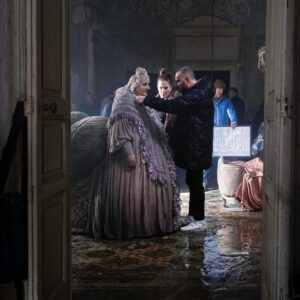 From there, I simply began drawing, designing. Ultimately, I made more than 60 costumes for all the characters in the movie. We made the costumes all brand new. Then we worked on them by dying and bleaching them out, sewing patches to them, and aging the costumes themselves. They had to have this tattered look in the movie because of the portrayal of a world of poverty. We were also able to rediscovery ancient techniques used in the 1880s for making garments. We also used fire and flames to work on the original fabric of the costumes so we could have a see through idea of the weaves in the fabric and textile of the costumes.
From there, I simply began drawing, designing. Ultimately, I made more than 60 costumes for all the characters in the movie. We made the costumes all brand new. Then we worked on them by dying and bleaching them out, sewing patches to them, and aging the costumes themselves. They had to have this tattered look in the movie because of the portrayal of a world of poverty. We were also able to rediscovery ancient techniques used in the 1880s for making garments. We also used fire and flames to work on the original fabric of the costumes so we could have a see through idea of the weaves in the fabric and textile of the costumes.
As far as the costumes are concerned, I again drew inspiration from the anthropomorphic figures so the colors you see in the costumes reflect the real color of the animals’ hide and hair.
BTL: Did you have a favorite costume from all the ones you worked on, and why?
Cantini Parrini: Well, they all become like your babies and favorites since you put so much work into them. The passion in working on these costumes is so high that it’s hard to have a preferred costume. They are all the result of the great amount of time and love I have devoted to making them and thinking them out.
But I was very proud eventually of the snail costume. I was very impressed once I saw it made, because the snail is the character which has the most animal features of all the costumes in this film. When I saw the actress in the costume, made up and with her hair done, she was gorgeous to look out. It was also one of the hardest ones to carry out because it required so many prosthetics to get it done. I had to travel to London quite often to take the right sizes and measurements, to make sure the proportions were right. The first ones I received were wrong so I had to do them again. The actress was wearing a huge suit underneath almost like a scuba diving suit underneath, it was a high degree of difficulty.

BTL: Is it fair to say that was the hardest costume to work on? If not, tell us which one was the hardest and why?
Cantini Parrini: Well the most difficult aspect of this film was making totally new costumes and then reducing them to tattered, aged costumes. We had to employ very delicate but involved procedures to do this, and we were scared that the costumes could become so fragile that they could be broken during the shootings, or that they would tear during the acting. Luckily enough the costumes held up. Beyond that, the most difficult part of my job is always the beginning of the creative process. Once I have the idea then everything becomes much easier for me.
Of course, my greatest fear is that what I have thought of making won’t be the right decision or the right choice, and maybe the director does not like it or the actors do not like to wear it. So finally when the moment arrives and the director and actors see it and if I get positive feedback, that is when I can finally relax and am satisfied with my work.
BTL: Is that how it occurred here? Did Garrone and the actors give you this type of feedback?
Cantini Parrini: Yes! They were very pleased from the beginning.
BTL: Other than the inspiration derived from the illustrations and the period, was there anything else for the Pinocchio costumes?
Cantini Parrini: These were interesting and the creative process was very, very long, because we could not figure out how Geppetto would have enough money or resources to put clothes on his son. First, we thought about curtains, but Geppetto did not have curtains in his house. I spoke to Matteo and we thought maybe of using a kitchen cloth of some form, but again, he did not have anything like that. His house was just so empty and he did not own many things, certainly not textile material. We thought about the tablecloth, but again—there was none.

Eventually we ended up with using part of the bed blanket and using a blanket as the basis for the costume. So the idea is that Geppetto made it from the fabric of his blanket. And it is very simple, ancient, and full of wear and tear. When Geppetto sews the costume for Pinocchio, the costume had to be very simple in design and have a very simple look—he is a woodworker, so he can give a good proportion of size, but he is no tailor, so he ends up making a very simple costume. The only highlight of the piece are the ruffles that Pinocchio has around his neck, because we thought it could recall the collar of an elementary school kid’s uniform. That was the only accessory we designed for his costume.
In terms of the color, I really had to struggle and fight so as to achieve the costume in red, to get that cleared. But it ends up being the only bright color of the whole movie, and I really wanted that color because it made him like a little ladybug fluttering from one adventure to another, and also because in my opinion red is the costume of human feeling.

One other thing is that in the original story, the costume that Geppetto makes for Pinocchio, the clothes are made of paper and the hat was made of breadcrumbs. But in terms of continuity here, if we had used paper the costume would have been destroyed during filming and if the hat had been made of bread, Geppetto would have eaten it.
BTL: What about the other puppets, how did you design them and how did you make sure they were different from each other?
Cantini Parrini: Yes, I worked on all of those and made new designs for them. This included the puppets, the circus protagonists, and everybody else. Because we really wanted this Pinocchio to be different from all the others, we made them new, from scratch, to be totally original. We did not want them to invoke a memory of any of the other films.
To achieve variety I simply inspired myself from Italian Comedia Dell’Arte—they are different masks from this genre. Each puppet has his own identity, whether it is the police officers, the devil, the joker, or whatever. We have seen these Italian traditions in Italy all our lives, so they are familiar to them, but I just gave them my own approach, I made them my own interpretation of those characters.
BTL: How will you be watching the Oscars next week?
Cantini Parrini: Sadly, I won’t be able to travel to Los Angeles because of the pandemic. We will be present in a studio in Milan watching the results. It is a pity because we will miss out on the vibes, emotions, feelings, the expectations of being all there together and waiting for the announcements. But I will be with my colleagues [Makeup Artist Dalia Colli, Hair Stylist Francesco Pegoretti] waiting together for the announcements. It is a special edition this year and we will have to go with it!
Roadside Attractions released Pinocchio theatrically in the United States on December 25, 2020, and it was released in Italy in December 2019. It is still playing in select theaters in North America.
(Behind the scenes photos courtesy Roadside Attractions — click for larger images.)
You can check out some of Massimo’s fantastic sketches for the costumes of Pinocchio below, as well as a specially-made Oscar clip showcasing his work on the movie. (All sketches courtesy Signore Cantini Parrini.)
For more thoughts on the Costume Design category, you can also read Neil Turitz’s thoughts and analysis.





